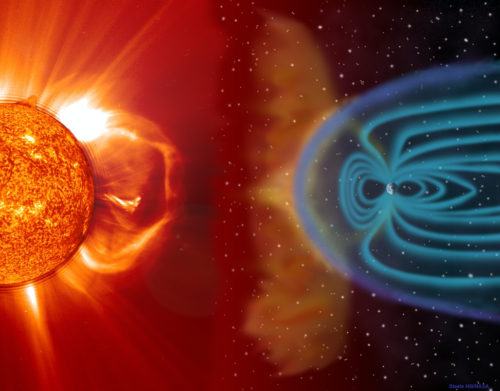Image courtesy of NASA.
The Moon has been the Earth’s companion since long before humans have lived on Earth. But new research shows that several billion years ago, the Moon played a far more important role. Researchers from the National Aeronautics and Space Administration (NASA), University of Maryland, and Princeton University found that the Moon may have helped protect the young Earth.
Our Sun, like other stars, spits harmful particles and radiation into the space around it. However, the Sun used to be more volatile than it is today. “Just like a baby, when the Sun is young, it’s energetic; when it grows old, it becomes less energetic. Go back to four billion years ago when the Sun was very energetic, and it emitted high stellar radiation and intense particle fluxes,” said Princeton University astrophysicist Chuanfei Dong. These particles and radiation have the power to strip away a planet’s atmosphere, so in order for a young planet to keep its atmosphere, it must be protected.
Planets use their magnetic fields to deflect most solar particles and radiation around and away from them, kind of like a planetary umbrella. The Earth has a protective magnetic field, but the Moon currently does not. However, a recent reexamination of lunar samples from the Apollo missions indicates that this wasn’t always the case. “Research was coming out from the Apollo rocks indicating that the Moon had a magnetic field in the past, and I really wanted to model it to determine what it was going to look like,” said James Green, NASA’s Chief Scientist.
Green’s team found that the Moon had a considerable magnetic field around four billion years ago that protected the young Earth. The Moon’s magnetic field acted as a second shield to protect the Earth’s atmosphere from the volatile young Sun. This finding has important implications for the search for extraterrestrial life outside of our solar system. Exoplanets with moons would be provided extra protection from their active stars, which means that they could be located closer to more volatile stars and still maintain life-supporting conditions.
In addition, the interaction between the Moon’s and the Earth’s early magnetic fields would have caused some of the Earth’s atmosphere to transfer to the Moon. Some of the Earth’s atmosphere would have traveled along the connected magnetic field lines and added to the early lunar atmosphere. While the Moon doesn’t have an atmosphere today, remnants of this combined atmosphere could be preserved in permanently shadowed craters on the Moon called cold traps. The Sun hasn’t shined in these craters since they were created billions of years ago, making them one of the coldest places in the solar system. Gas that traveled from the Earth to the Moon would have been attracted to these cold traps and should still be trapped there today. This means that by studying the Moon today, we can figure out what Earth’s early atmosphere was composed of. “It’s interesting to think that the early Earth atmosphere—which was almost impossible for us to figure out—could actually be waiting for us to discover on the Moon,” Green said.
The results of this study will help determine a research focus of NASA’s Artemis program. Artemis is anticipated to begin next year and will land the first woman and the next man on the Moon by 2024. With the Artemis program, NASA plans to establish sustainable lunar exploration by the end of the decade. “In the Artemis program, what we need to do is go into these permanently shadowed craters and take ice cores. Not only would water be [in those cores], but so would elements of the early atmosphere of both the Earth and the Moon. In fact, current thinking is that there’s probably anywhere from a hundred, two hundred, maybe three hundred million tons of water in these craters, and a significant portion of that may have come from the Earth,” Green said.
Green also stressed the fact that this type of space research is crucial to understanding Earth. Our solar system has given us the unique opportunity to see other terrestrial planets such as Venus and Mars near us and at radically different points in their planetary evolutions. “It gives us an opportunity to compare, understand, and recognize what the fate and evolution of our own planet are all about,” Green said. By studying other planets and uncovering Earth’s past, we can gain a better understanding of where Earth currently is in its evolutionary path, and where it’s headed in the future.
Sources:
Dunbar, B. (n.d.). Artemis. Retrieved November 08, 2020, from
Green, J., Draper, D., Boardsen, S., & Dong, C. (2020). When the Moon had a magnetosphere. Sci. Adv (Vol. 6, pp. 865–879). Retrieved from
Landau, E. (2020, October 14). Earth and Moon Once Shared a Magnetic Shield. Retrieved November 08, 2020, from

